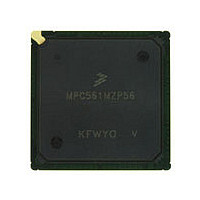MPC561MZP56 Freescale, MPC561MZP56 Datasheet - Page 380

MPC561MZP56
Manufacturer Part Number
MPC561MZP56
Description
Manufacturer
Freescale
Datasheet
1.MPC561MZP56.pdf
(1420 pages)
Specifications of MPC561MZP56
Cpu Family
MPC56x
Device Core
PowerPC
Device Core Size
32b
Frequency (max)
56MHz
Interface Type
QSPI/SCI/SPI/UART
Total Internal Ram Size
32KB
# I/os (max)
56
Number Of Timers - General Purpose
22
Operating Supply Voltage (typ)
2.6/5V
Operating Supply Voltage (max)
2.7/5.25V
Operating Supply Voltage (min)
2.5/4.75V
On-chip Adc
2(32-chx10-bit)
Instruction Set Architecture
RISC
Operating Temp Range
-40C to 125C
Operating Temperature Classification
Automotive
Mounting
Surface Mount
Pin Count
388
Package Type
BGA
Program Memory Type
ROMLess
Program Memory Size
Not Required
Lead Free Status / RoHS Status
Not Compliant
Available stocks
Company
Part Number
Manufacturer
Quantity
Price
Company:
Part Number:
MPC561MZP56
Manufacturer:
Freescale Semiconductor
Quantity:
10 000
Company:
Part Number:
MPC561MZP56R2
Manufacturer:
Freescale Semiconductor
Quantity:
10 000
- Current page: 380 of 1420
- Download datasheet (11Mb)
External Bus Interface
9.5.8.7
This signal is sent from the master to the slave to indicate that there is a data beat following the current
data beat. The master uses this signal to give the slave advance warning of the remaining data in the burst.
BDIP can also be used to terminate the burst cycle early. Refer to
Section 9.5.5, “Burst
Base Registers
9.5.9
The EBI uses three termination signals:
9.5.9.1
Transfer acknowledge (TA) indicates normal completion of the bus transfer. During a burst cycle, the slave
asserts this signal with every data beat returned or accepted.
9.5.9.2
A slave sends the BI signal to the master to indicate that the addressed device does not have burst
capability. If this signal is asserted, the master must transfer in multiple cycles and increment the address
for the slave to complete the burst transfer. For a system that does not use the burst mode at all, this signal
can be tied low permanently. Refer to
for BI options.
9.5.9.3
The TEA signal terminates a bus cycle under one or more bus error conditions. The current bus cycle must
be aborted. This signal overrides any other cycle termination signals, such as transfer acknowledge.
9.5.9.4
The transfer protocol was defined to avoid electrical contention on lines that can be driven by various
sources. To this end, a slave must not drive signals associated with the data transfer until the address phase
is completed and it recognizes the address as its own. The slave must disconnect from signals immediately
after it has acknowledged the cycle and no later than the termination of the next address phase cycle. This
means that the termination signals must be connected to power through a pull-up resistor to avoid the
situation in which a master samples an undefined value in any of these signals when no real slave is
addressed.
9-40
Refer to
1
•
•
•
Cases in which both TS and STS are asserted indicate normal cycles with the show cycle attribute.
Transfer acknowledge (TA)
Burst inhibit (BI)
Transfer error acknowledge (TEA)
Figure 9-28
Termination Signals
Burst Data in Progress
Transfer Acknowledge
Burst Inhibit
Transfer Error Acknowledge
Termination Signals Protocol
(BR0–BR3)” for memory controller BDIP options.
Mechanism” for more information. Refer to
and
Figure
MPC561/MPC563 Reference Manual, Rev. 1.2
9-29.
Section 10.9.3, “Memory Controller Base Registers
Section 9.5.4, “Burst
Section 10.9.3, “Memory Controller
Freescale Semiconductor
Transfer” and
(BR0–BR3)”
Related parts for MPC561MZP56
Image
Part Number
Description
Manufacturer
Datasheet
Request
R

Part Number:
Description:
MPC5 1K0 5%
Manufacturer:
TE Connectivity
Datasheet:

Part Number:
Description:
MPC5 500R 5%
Manufacturer:
TE Connectivity
Datasheet:

Part Number:
Description:
MPC5 5K0 5%
Manufacturer:
Tyco Electronics
Datasheet:

Part Number:
Description:
MPC5 5R0 5%
Manufacturer:
Tyco Electronics
Datasheet:

Part Number:
Description:
MPC5 50K 5%
Manufacturer:
Tyco Electronics
Datasheet:

Part Number:
Description:
MPC5 1R0 5%
Manufacturer:
Tyco Electronics
Datasheet:

Part Number:
Description:
TOWER ELEVATOR BOARDS HARDWARE
Manufacturer:
Freescale Semiconductor
Datasheet:

Part Number:
Description:
TOWER SERIAL I/O HARDWARE
Manufacturer:
Freescale Semiconductor
Datasheet:

Part Number:
Description:
LCD MODULE FOR TWR SYSTEM
Manufacturer:
Freescale Semiconductor
Datasheet:

Part Number:
Description:
DAUGHTER LCD WVGA I.MX51
Manufacturer:
Freescale Semiconductor
Datasheet:

Part Number:
Description:
TOWER SYSTEM BOARD MPC5125
Manufacturer:
Freescale Semiconductor
Datasheet:












